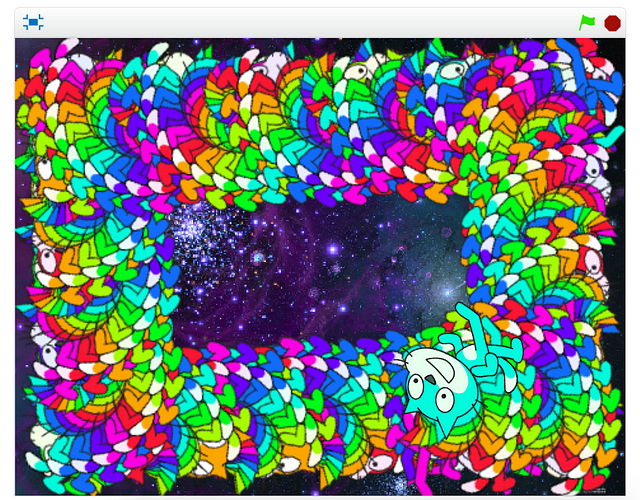Meet the Scratcher: Katie Scheutzow
Meet the Scratcher: Katie Scheutzow
By My Nguyen
Originally published on the Scratch Foundation BlogWhen rising 8th grade student Katie Scheutzow was younger, she wanted to be just like her dad, who is a programmer. As she got a bit older, she participated in coding clubs and camps, where she discovered that programming really was “her thing.”
Earlier this year, Katie coded a software program that could help visually-impaired people bank at ATMs by using basic hand motions. Programmed with Scratch, Katie’s “Banking for the Blind” prototype uses video sensing technology and audio prompts to carry out tasks such as making a deposit, withdrawing money, and checking a balance.

After multiple tests and 12 different iterations of the project, Katie’s final prototype won her the Financial Award at the inaugural National Invention Convention and Entrepreneurship Expo (NICEE) in May and a college scholarship and second place in the nation in the grade 7–8 level at the National Invention Convention.
Katie’s efforts have also landed her two internships through St. Ambrose School’s STEM Accelerated Coding program. This summer, Katie will intern with the Cleveland Sight Center, as well as with United Cerebral Palsy of Greater Cleveland, where she’ll learn about sight technology, testing, databases, and networks.
The Scratch Foundation recently spoke to Katie to learn more about her invention.
How did you find out about Scratch?
I was in sixth grade and decided to join a coding class. The first program that we used was Scratch. I had actually heard of Scratch previously because a couple of my friends had used it before. They made these jetpack games and let me test them out. I became interested in learning more because I had a lot of ideas for games and projects that I could create.
Do you remember the first project you created with Scratch?
The first program I can remember making was a program about the Scratch Cat. I programmed it to move around the screen, change colors, and stamp. I remember thinking, “Wow, I did that!” I was really proud of myself for making that cat move. Then I showed it to all of my friends, and I taught them how to create their own. It’s a really great moment when you realize how much you can actually do with coding.

What motivated you you to create Banking for the Blind?
It started with the science fair. My teacher mentioned that nobody had ever done a science fair project with technology before, so I searched online for some ideas that I might be able to branch off of. The first thing that popped up was making a game with Scratch programming. I decided to look into what I could do with Scratch. There were a lot of options! At the time, my coding teacher Beth was just introducing us to visual sensing, so I asked her for suggestions of projects that I could do involving visual sensing. She recommended doing a project related to visually-impaired people. I took it from there.
Can you describe the design process?
Well, I thought I knew exactly what I was doing, but I didn’t know everything. In total, I had 12 different versions of my project!
I started off with just brainstorming ideas. I made sure that my idea was original, and then I tested out visual sensing to see how far I could go with it. I tested my project many times to find the bugs. It couldn’t have too many features or else it became slow and buggy. It took me about a week or so to complete the final version of my project. It was frustrating at first, but it got easier once I understood what I was doing. My first attempt actually failed completely.
What was the most challenging part of this project?
The most challenging part was the debugging. I’d go to use the video sensing, wave my hand up to deposit money, and it just wouldn’t work. Sometimes, I didn’t know what to do! Even though it was frustrating, I was proud and satisfied with myself once it was all done. Really, the best thing to do if you’re doing a project similar to mine is to write down the bugs you have. It would have made programming my project a lot easier if I didn’t repeat my mistakes.

What was the most rewarding part of this project?
I liked putting my idea out there and having people tell me, “Hey, you can do this to improve,” or, “Hey, I just really like your project.” I liked explaining my process to people. I think I even inspired a couple of people. Some of them came up to me and asked, “Hey, can you tell me how you did this and this with your code?” Some of them asked me what program I used, and I made sure to tell them that I used Scratch.
What advice do you have for other students who don’t know if programming is “for them”?
If you want to get into programming, but you’re not sure you’re really going to like it, I suggest exploring the Scratch community. There are really amazing projects out there — that’s what inspired me to code and to make projects like Banking for the Blind. Or just try out some camps or clubs or classes like I did. You can always decide, “Hey, I don’t want to do this anymore, it’s not for me.” Or, you might really like it.
What’s next for you?
This summer, I want to try to learn some more coding languages, like Java or HTML, and also to look further into Scratch. Maybe I’ll come up with a big project to work on throughout the year.

